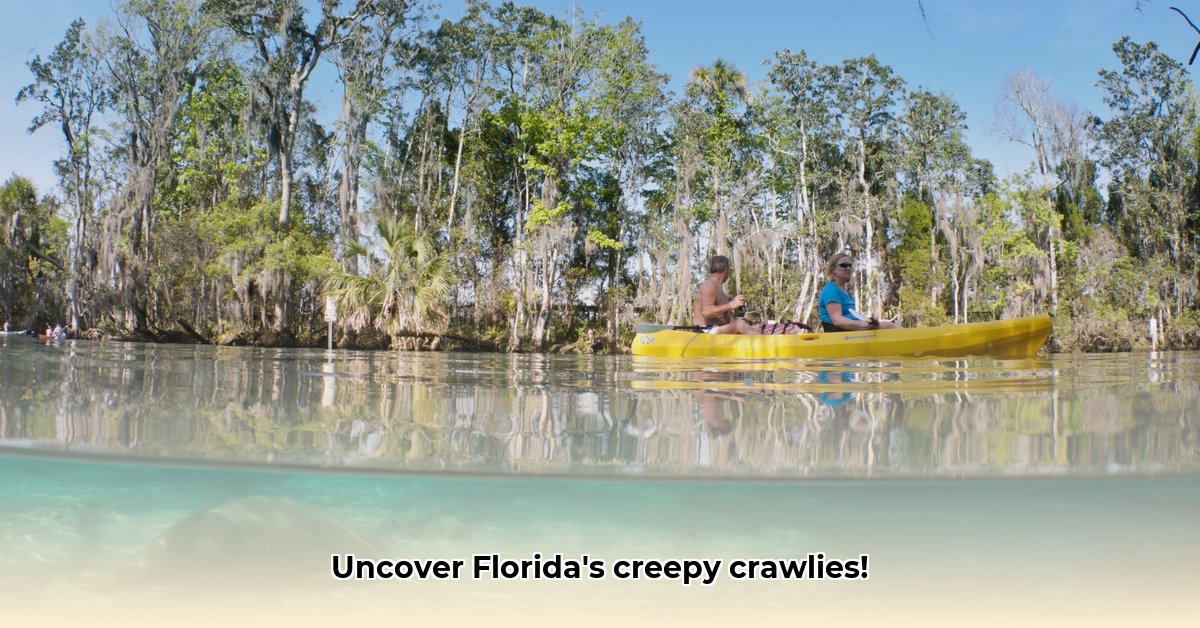Florida’s climate provides a haven for various spiders, ranging from harmless and beneficial species to those that demand respect and caution. Identifying these spiders accurately is essential for determining whether they pose a threat to your home and family. For more information on recluse spiders, check out this helpful guide: Recluse Spider Identification. This comprehensive guide will equip you with the knowledge to distinguish between common Florida house spiders, allowing you to differentiate between the friendly and the potentially dangerous ones. Learn to identify potentially dangerous spiders, such as black widows and brown recluses, using clear visuals, safe spider removal techniques, and effective preventative measures. Understand why some Florida spiders are more dangerous than others and explore strategies for keeping spiders out of your home. Let’s delve into the world of Florida house spiders, transforming anxiety into informed action.
Identifying Common Florida House Spiders and Their Habitats
Florida’s warm, humid climate attracts spiders into our houses. Most are harmless and even helpful, so knowing how to identify them is important for both your peace of mind and the spiders’ well-being. Accurate identification is crucial; use field guides or online resources with high-quality images. A magnifying glass can help you see small details.
Distinguishing Venomous vs Non-Venomous Spiders
- Most Florida spiders are harmless. Recognizing the few that pose a risk is crucial.
- Accurate identification is key to safety. Misidentification can lead to unnecessary fear or dangerous complacency.
- Understanding spider characteristics helps. Knowing their unique markings and behaviors aids in quick identification.
Black Widow Spiders: Identification and Control
Black widow spiders (Latrodectus spp.) are easily identified by their shiny, black bodies and a red hourglass marking on their underside. Juvenile black widows may exhibit a less defined hourglass, so caution is advisable when encountering any small, black spider. These spiders frequent dark, undisturbed areas, such as woodpiles, garages, and cluttered storage spaces. They construct irregular webs and are generally reclusive, but their venom is potent.
If you suspect a black widow infestation, it is crucial to proceed with caution. Wear gloves and protective clothing when working in areas where they might be present. Consider contacting a pest control professional experienced in safely removing black widow spiders.
Brown Recluse Spiders: Identification and Safety Measures
Brown recluse spiders (Loxosceles reclusa), while less common in Florida than in other parts of the United States, are still a concern. They are identified by a violin-shaped marking on their cephalothorax; however, this marking may not always be clearly visible. Brown recluses also have six eyes arranged in pairs, unlike most spiders with eight. These spiders prefer secluded spaces, such as closets, under furniture, and behind baseboards.
Bites from brown recluse spiders are rare, but can cause serious symptoms in some individuals. Seek immediate medical attention if you suspect a bite, particularly if you experience intense pain, blistering, or fever.
Common House Spiders: Identification and Ecological Role
Common house spiders are frequently seen in homes. They are brownish or grayish with varied patterns and create messy, irregular webs in quiet areas. They are not aggressive and pose little threat to humans. These spiders are beneficial, controlling indoor insect populations. Spiders play a role in maintaining ecological balance within your home by preying on insects like flies, moths, and mosquitoes.
Jumping Spiders: Characteristics and Benefits
Jumping spiders (Salticidae) have large, forward-facing eyes that give them excellent vision. They are active hunters, stalking prey instead of using webs. You’ll see them roaming surfaces. They are fascinating to watch and are harmless to humans. These spiders are agile hunters that help control populations of small insects in and around your home.
Wolf Spiders: Habitat and Behavior
Wolf spiders (Lycosidae) are larger, hairier spiders that live on the ground and don’t build webs. They actively hunt for food on floors. While they may seem intimidating, wolf spiders are not usually aggressive unless threatened. These spiders are fast-moving hunters that can be found both indoors and outdoors. They play a role in controlling ground-dwelling insects.
Controlling and Preventing Florida House Spiders: Expert Advice
Most Florida house spiders are harmless and beneficial, acting as natural pest control, but managing potentially dangerous spiders is essential. Prevention is the best way to keep spiders out.
Eliminating Spider Entry Points
- Seal it up: Caulk cracks and gaps in walls, foundations, and windows to stop spiders from entering, especially around pipes and wires. Focus on sealing entry points in areas where spiders are commonly found, such as basements, attics, and garages.
- Declutter: Reduce clutter to minimize hiding places; spiders prefer dark, undisturbed areas. Remove stacks of newspapers, cardboard boxes, and other items that provide shelter for spiders and their prey.
- Regular Cleaning: Regular vacuuming and dusting will remove webs and spiders, focusing on corners, furniture, and baseboards. Pay particular attention to areas where spiders are likely to build webs, such as ceilings, corners, and under furniture.
- Landscaping: Keep vegetation trimmed back from your house to reduce spiders moving inside. Trim shrubs, bushes, and trees that touch the exterior of your home, as these can serve as bridges for spiders to enter.
Handling Venomous Spider Encounters
- Observe from a distance: Don’t handle the spider. Observe it to confirm identification. Use caution and avoid getting too close to the spider.
- Relocation (if comfortable): Gently capture the spider in a jar with a lid and release it outdoors far from your home. Wear gloves and protective clothing to minimize the risk of being bitten.
- Professional Help: If unsure or uncomfortable, contact a pest control professional. A trained professional will be able to identify the spider and safely remove it from your property.
- Medical Attention: If bitten, seek immediate medical help, especially with worsening symptoms, as black widow and brown recluse bites require prompt medical care. Monitor the bite site for signs of infection or allergic reaction.
Managing Harmless Spiders
Relocating harmless spiders is sufficient. Capture them gently and release them outside. If the spider doesn’t bother you, leave it alone, as they control insect populations. Consider the benefits that spiders provide in controlling other pests before deciding to remove them.
Understanding the Ecology of Florida House Spiders
Spiders are vital to Florida’s ecosystems. They control insect populations, many considered pests. Most spiders are our allies, helping maintain a healthier environment, even if we don’t want them in our homes.
Maintaining a balanced view is crucial. We share space with these creatures. Responsible management involves understanding their ecological role and making informed coexistence decisions. Think of your home’s spider population as a small, contributing part of a larger ecological system. Ongoing research reveals new insights into spider behavior and ecology, so our understanding and approaches are always evolving, improving the overall level of spider control in Florida.
Differentiating Harmless Florida Spiders from Venomous Ones
Florida’s spider population is diverse with many harmless and helpful species. However, some venomous spiders live in Florida; therefore, knowing how to differentiate between harmless and venomous spiders is crucial for our safety.
Identifying Venomous Spiders: Widows and Recluses
Florida’s venomous spiders are mainly black widows and brown widows. Although brown recluse spiders are sometimes reported, their presence in Florida is debated.
- Black Widows: These shiny, black spiders have a distinctive red hourglass marking on their abdomen and build irregular webs in dark, undisturbed areas. Check woodpiles, garages, and sheds for black widow spiders and their webs.
- Brown Widows: Similar to black widows, their hourglass is orange or brownish-yellow and often broken. They can be found in similar habitats as black widows, and are also often found around buildings.
- Brown Recluses (Debated Presence): These spiders have a dark violin-shaped marking on their cephalothorax (body section) and are venomous, although misidentifications are frequent. Look for brown recluse spiders in secluded areas like closets, attics, and under furniture.
Identifying Harmless House Spiders
The vast majority of spiders found in Florida homes are entirely harmless. Several common types reside in Florida homes:
- Wolf Spiders: Often confused with venomous species, they are not dangerous and are beneficial predators who don’t build webs, instead they hunt prey. Wolf spiders can be identified by their large size, hairy bodies, and hunting behavior.
- Orb Weavers: These spiders create beautiful, spiral-shaped webs, are usually shy and non-aggressive, and their bite is typically harmless. Orb weaver spiders are often found in gardens and yards, where they build large, intricate webs to capture flying insects.
- Jumping Spiders: These small, active spiders are known for jumping and are harmless. Jumping spiders can be identified by their large, forward-facing eyes and jumping locomotion.
- Daddy Longlegs (Harvestmen): Not actually spiders, but harmless arachnids with long legs. Daddy longlegs are often found in damp areas such as basements and crawl spaces.
How Visual Cues Aid in Spider Identification
- Body Shape and Size: Venomous spiders often have a more rounded abdomen. Take note of the overall shape and size of the spider’s body, which can provide clues to its identity.
- Color and Markings: The hourglass shape on widows is a clear identifier, and brown recluses have a violin-shaped marking. Pay close attention to any distinctive markings or patterns on the spider’s body.
- Gluten Free Meal Prep Ideas for Delicious, Hassle-Free Eating - November 28, 2025
- Gluten Free Meal Prep for Stress-Free and Healthy Eating - November 27, 2025
- Quick And Easy Chicken Thigh Meal Prep For Weight Loss - November 26, 2025










